No matter what your goal may be, focusing on recovery is an important part of making sure you reach it. That’s because it’s only when your body is recovering that it’s improving.
To get started unlocking the power of recovery, follow the guidelines below.
Note: a HRV / recovery test with the Morpheus M7 is required to fully unlock the app’s features.
HRV Best Practices
Because HRV is a sensitive measurement, it’s important to follow a few testing guidelines no matter which device you’re using. This will make sure you get the most accurate results possible.
- Try to take your measurement in the morning each day if possible. Usually within 10-30 minutes of first waking up is best.
- Avoid stimulants or anything that can increase your heart rate immediately before the measurement.
- Try to stay relaxed throughout the test. Avoid talking, eating, moving, checking social media, etc until the test is complete.
- Breathe naturally. Do not try to follow a specific breathing pattern or hold your breath during the test.
- Try to take your measurement in a place that’s quiet and free from distractions as much as possible.
- Make sure to take your measurement in the same position, laying down or seated, each time. If your resting heart rate while lying down and awake is in the low 40s or less AND your HRV is above 90, a seated measurement is recommended. Otherwise, lying down is preferred.
Checking your recovery
Open the Morpheus app and select “CHECK RECOVERY” from the middle of the app home screen.
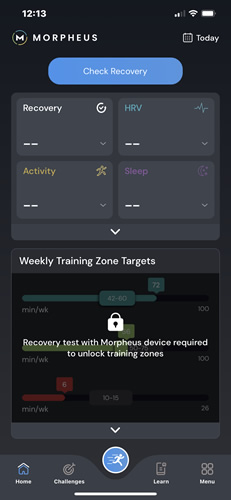
Once you’ve done that, you will taken to the recovery questionnaire page to enter your hours of sleep, sleep quality, soreness, and your overall well-being.
You can also add any notes that you’d like to track as well.
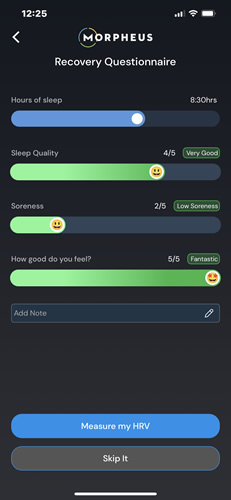
Once you’ve filled the questionnaire out, you can choose to measure your HRV or “Skip it.”
Note that to fully unlock Morpheus, you will need at least one HRV measurement.
Although daily HRV measurements are not required, it’s recommended to include one in your daily routine as consistently as possible for the highest level of accuracy.
Measuring HRV
Because your first recovery test is used to set your weekly target zones, it’s highly recommended that your first test (all all future ones) be done in the morning shortly after waking up, to ensure the highest accuracy possible.
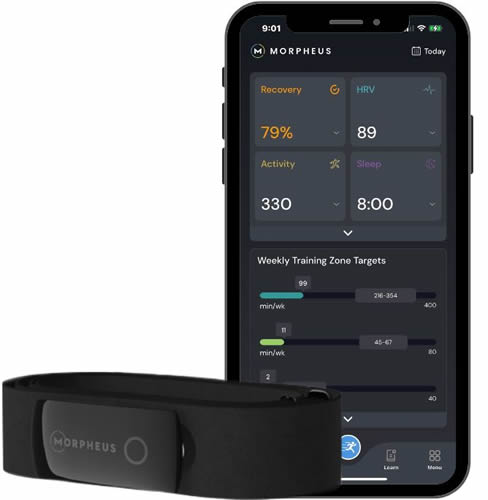
Important: You will need to turn the M7 on before you can connect it to the Morpheus app. To do this, you must be wearing it appropriately.
For important info and tips regarding wearing and using the M7 heart rate monitor, please visit the link below.
**If you’d prefer to do your HRV test with an armband device and dedicate your M7 to training, the Scosche Rhythm 24 is the only device other than Morpheus devices that is compatible for the test in the Morpheus app. It is available on the Scosche website and on Amazon. If you are not located in the US, you can purchase on Amazon by using the .com ending to the URL. Note that the Morpheus M7 is still required to fully unlock the Morpheus app.
Once you select “Measure my HRV” from the recovery questionnaire, you then connect the M7 to the app by hitting “Connect HRM” and then selecting it from the list of devices.
If it doesn’t appear, give it a few seconds for the app to detect it.
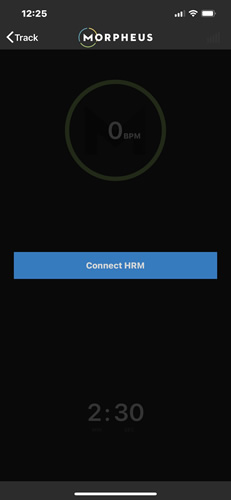
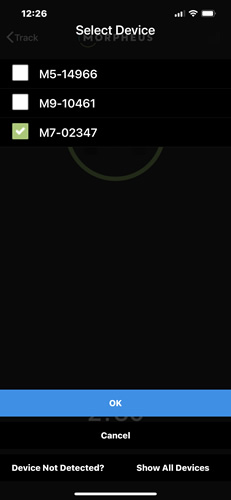
Once the app has found and connected to the M7, it will display, “searching for HR” while it looks for heart rate from the M7 sensor. As soon as your heart rate is detected, it will be displayed and the “START” button will turn appear on the screen.
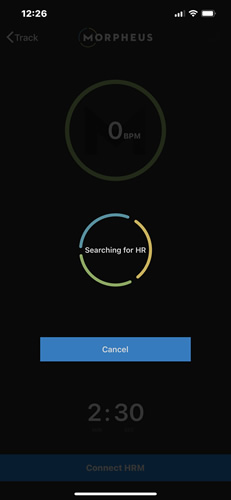
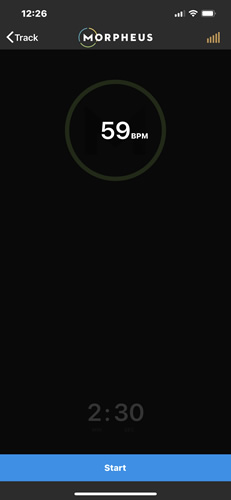
It’s recommended to wait until your heart rate is stable before pressing “START” to begin the test. Once you’ve pressed “START” Morpheus will also to make sure the reading is stable and then automatically begin the 2:30 HRV test.
The stabilization detection is to ensure the HRV test is as accurate as possible. For more guidelines on accuracy, refer to the “Best Practices” at the top of this lesson.
As soon as the HRV test is complete, you will be redirected to the home screen, where your recovery score and HRV will be displayed.
With the recovery check complete, your heart rate zones will also be set for the day as well.
Note that it generally takes 5-7 days to establish your HRV baseline. Because of this, your recovery score will be less accurate the first few days that you begin using Morpheus.
It’s recommended to give it about 1 week of using Morpheus before you start relying on the recovery score to drive your training and fitness.
Skipping the HRV test
While it’s recommended to measure your HRV as consistently as possible, it is not required for Morpheus to calculate a recovery score. Based on millions of data points, Morpheus is now able to predict your HRV and give you a recovery even without an HRV test.
When you hit choose to skip the HRV test, you will immediately be redirected to the home screen.

Note that at least one HRV measurement is required to unlock all the Morpheus features and the more frequently you measure HRV, the more accurate your training zones and weekly zone targets will be.
Your Recovery Score
After your Recovery Test, your recovery score for that day will appear on the Home Screen as a percentage (%) from 1-100%.
IMPORTANT: When first starting with Morpheus, your recovery score may appear as “100%.” Morpheus will take 7-10 days of consistent use to establish your personal baseline. The more data Morpheus collects, the more accurate it will become.
Note that if you stop using Morpheus for more than 7-10 days, you’ll need to re-establish your baseline.
You’ll notice that your recovery score will appear as green, amber, or red. These colors are assigned based on your total recovery percentage, as follows:

There are several factors that determine your recovery score. Below is an overview.
HRV sets the range of possible recovery score %. It is always using a rolling 10-day average HRV number. This average forms a horizontal white line in the app on the HRV data view. The further away your HRV is on any day relative to your 10-day rolling average HRV, the lower your recovery score will be.
Here is a picture example of HRV deviating below and above the white line avg which caused a large drop in recovery score.
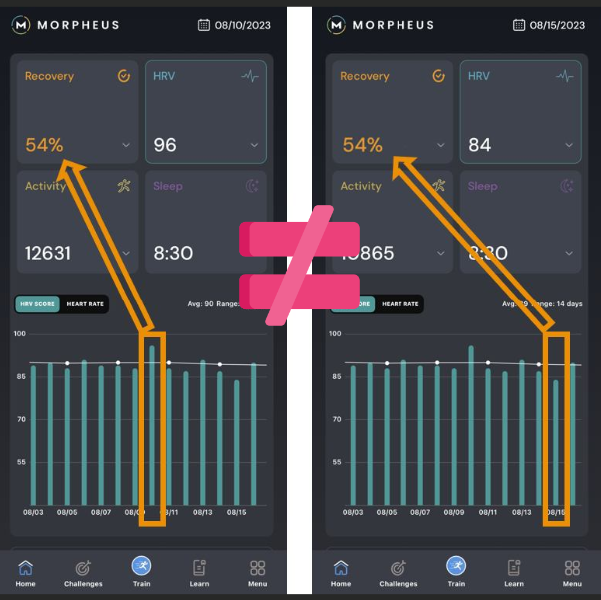
Then the other factors slide recovery score up and down within that range to set the specific value for each day.
Resting heart rate, sleep quality rating, and the previous day’s training session (it looks at the post-workout recovery +/- value) play the biggest role, with other data and subjective markers of fatigue (such as level of soreness and how you feel) playing a smaller role.
The weighting also changes a bit based on the consistency of HRV measurements. If you have only taken 3 HRV measurements in the last 10 days, it’s going to create a bigger range of possible recovery scores and more heavily weight the other data.
HRV will always be the single biggest factor in your recovery score because it should reflect stress as a whole, but the other variables added together can typically swing your recovery score 10-20% or so.
Lastly, there will be times when your recovery score may not make sense to you at first glance. You may feel good, you slept well, you didn’t workout hard, and you don’t have any extra perceived stress, but your recovery score may still be low. There are many factors that influence HRV, and only a small number of those can be controlled. The others are all subconscious or automatically controlled by the autonomic and central nervous systems…so you may not even be presently aware of and may never be aware of. There’s always a physiological reason for it. But sometimes it will seem to make sense, sometimes it won’t. If you could always “feel your recovery” then there would be no point to use any tool that measures HRV. It’s best not to get hung up on a single day, but instead to focus on principles of recovery and implement them over time.
For more information, be sure to read through the HRV and Recovery section of this Morpheus 101 guide.
FAQ & Troubleshooting
Q: Can I take my recovery test more than once per day?
No, Morpheus is designed for one HRV measurement per day. This is because Morpheus works by comparing your HRV each day to your baseline. Measuring HRV multiple times per day decreases accuracy and makes it more difficult to track trends and changes.
To understand more about how Morpheus calculates the recovery score, click here.
For more information regarding how to get the most out of your M7, please see our FAQ & Troubleshooting lesson a bit later in this 101 course.
Direct link here.
If you need additional help with your M7, please don’t hesitate to contact us by sending us a support ticket from the Morpheus app, or by clicking here to submit a support ticket.
We answer all support tickets and email within 24 hours Monday – Friday and are happy to help make sure you’re getting the most out of your M7.
